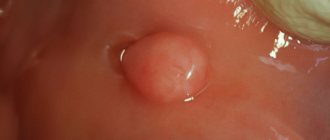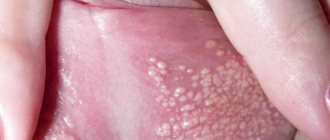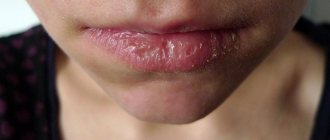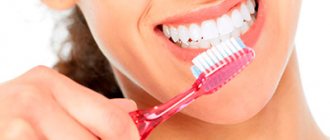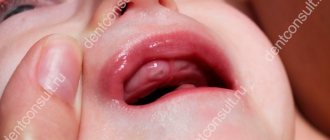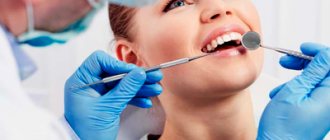What are Fordyce granules on the lips?
Fordyce spots are small white, yellowish skin granules that are visible on the lips, in places where sebaceous glands accumulate.
They appear under the skin, are harmless and non-contagious. These sebaceous secretions are named after the American dermatologist John Addison Fordis, who first described them in medical literature. The spots range in size from 1 to 3 mm and can be single or combined into one large group.
The lips are clearly visible when stretched. The granules do not spread bacteria or viruses, so they are not classified as a disease, but only as a condition of human skin. White spots cause psychological discomfort, embarrassment of a person, and the quality of life decreases.
Types of Fordyce granules on the lips
Fordyce granules on the lips (which are treated if they grow very large) can appear in various forms:
- A small or large yellow-white bump on the edge of the lip.
- Single or numerous white painless nodules in the form of bumps on the red lip area.
- Granule-like cyst under the skin.
- White granular nodules that appear on the lip when it is stretched.
- White symmetrical roughness on both sides of the lip.
Sometimes granules are confused with protruding herpes. The difference is that oral herpes appears as fluid-filled blisters that burst and crust over.
Stages and degrees of Fordyce granules on the lips
Although these spots become noticeable during puberty, they are already present at the time of birth. They remain invisible until the teenage stage of a person.
At the next stage of development, during puberty, hormonal changes give rise to the appearance of nodules on the lips. According to doctors, this is facilitated by the close location of the sebaceous glands to the upper layer of the epidermis. Incorrect location of the glands, on the edge of the lips or mucous membrane, causes the appearance of nodules.
The spots become highly visible in older adults. This is due to the fact that the older a person gets, the more sebaceous glands he develops. They enlarge with age, causing Fordyce granules to grow and develop into white bumps.
Description
Fordyce's disease manifests itself in the form of light-colored pimples (sebaceous glands), which can form on the oral mucosa, in the lips, cheeks, on the female labia, in the groin area in men, on the nipples of the breast, on the surface of the male penis. These light-colored pimples are also called Fordyce granules, which are considered normal, but can cause a rather unpleasant feeling of discomfort.
Fordyce granules are not considered a deviation from the norm, are not capable of causing complications, do not cause harm to health and are not transmitted to a partner during sexual intercourse. More than 35% of women and 60% of men suffer from Fordyce disease.
To date, scientists have not been able to establish the true reasons that provoke changes in the sebaceous glands. However, it is believed that one of the reasons that can trigger the development of this disease is that the sebaceous glands shift to the upper layer, as a result of which they are much closer to the epidermis - this is an abnormal location of the sebaceous glands.
Also, the patient may experience hypertrophy or hyperplasia of the excretory ducts of the sebaceous gland, which can result in the formation of a cyst, that is, blockage or narrowing of the duct itself occurs, with further accumulation of sebum (secret) in the gland.
The period of cyst formation is most often associated with the onset of puberty. This is why Fordyce granules begin to appear in adolescents between the ages of 13 and 17 years.
Consequently, if a child was born with an already displaced (abnormal) location of the sebaceous glands, with the onset of puberty, during which the influence of male sex hormones (androgens) occurs, the glands gradually begin to enlarge, which as a result provokes the formation of a large amount of sebaceous fat (secretion). ). All this leads to the visible manifestation of the sebaceous glands, which is called Fordyce's disease.
Despite the fact that to date it has not been possible to accurately establish the causes of Fordyce’s disease, dermatologists are confident that a combination of several different factors can lead to this phenomenon:
- narrowing of the ducts, resulting in the accumulation of skin secretions, which leads to blockage of the sebaceous gland;
- the presence of serious injury to the excretory duct of the sebaceous gland;
- failure to comply with personal hygiene rules;
- smoking;
- hormonal changes that occur in the human body - this may be puberty, the development of an adrenal tumor, hormonal imbalance, etc.
Pearly penile papules are a type of Fordyce granules and are considered normal, since they do not cause any harm to human health, are not capable of causing complications and are not transmitted during sexual intercourse. This type of rash can occur in approximately 30% of young men, and there is currently no known effective treatment for this type of rash.
To date, doctors cannot accurately determine the cause that provokes the appearance of pearlescent papules. The level of androgens in the blood can influence the development of such a rash, since during puberty not only the formation, but also rapid growth of papules can be observed, and after this period is completed, they decrease or completely disappear.
Therefore, we can conclude that the formation of pearlescent papules is due to the fact that a sharp increase in the level of androgens stimulates a more intense secretion of the sebaceous glands of the glans penis, as well as an increased secretion of sperm, which can have an irritating effect on the epithelium and provokes fibroplastic proliferation of papules, then there is their growth.
With Fox-Fordyce disease, as is correct, the localization of the lesion occurs in the pubic and axillary area, in the area of the labia majora, around the nipples or on the perineum. Quite often, the lesion also affects other areas of the skin located near the site of the lesion.
There are cases when the patient has a close cluster of conical or semicircular papules that have an almost normal color, with highly pigmented skin between them. This disease can be accompanied by severe or moderate skin itching, which can increase significantly during menstruation. If you are constantly bothered by severe itching or an unpleasant burning sensation, you should seek help from an experienced doctor.
Factors provoking the appearance of neoplasms
Today there is no exact opinion about the reasons for the appearance of these papules, but there are still several reasons that should be considered provoking factors:
- Imbalance in hormonal structures. Usually this change is associated with the period of maturation, but sometimes with neoplasms in endocrine structures. Age conditionality. Adolescents during puberty are most susceptible to cyst formation. This is due to increased production of male hormones. Androgens lead to hyperplasia of glands of exocrine origin, which leads to increased secretion production by the sebaceous glands.
- Ignoring the rules of personal care and hygiene. The activity of pathogenic bacterial microflora serves as a good environment for the development of skin diseases.
- Injury. Damage to the ducts responsible for the removal of sebaceous glands leads to blockage and the development of this disease.
- Addiction to bad habits can provoke unpleasant consequences, including the occurrence of this pathology.
- Formation of secondary sexual characteristics or puberty. During this age period, white formations often appear on various parts of the body. In representatives of the stronger sex, Fordyce granules appear on the head of the male genital organ and on the foreskin surrounding it. Such manifestations are completely safe and do not provoke unpleasant sensations, in addition to an external cosmetic defect. In females, rashes from Fordyce's disease on the intimate organs are light or beige in color. When palpated, a rough surface is revealed. They do not provoke pain, do not cause itching and do not increase in size over time. They often go away completely after the period of sexual activity ends.
- Problems with the sebaceous glands or their incorrect location. Doctors say that people who have these manifestations of the body are most susceptible to cyst formation.
This disease is not caused by genetic factors and occurs in individual cases in each patient.
Causes of appearance, who is at risk
Experts believe that the main reason for the appearance of formations on the lips is the incorrect (abnormal) location of the sebaceous glands.
There is no exact information about the mechanics of their appearance, but doctors identify additional reasons and factors that may affect the development of the negative process:
- certain types of hormonal disorders - from temporary imbalances (due to medication) to serious diseases or complications;
- metabolic changes in the system or in the body as an integral structure;
- adolescence (puberty, the beginning of menstruation in girls);
- hyperlipidemia - the problem is a lipid disorder that is directly related to increased body fat;
- disruptions in the blood circulation process occur - as a result, the accumulation and expansion of the sebaceous glands on the surface of the skin occurs;
- genetic predisposition - the problem passes from parents to child in 90% of cases;
- skin pores are too large and clogged . Oil from the sebaceous glands can form plugs and blockages. Such conditions are ideal for the formation of Fordyce granules;
- the natural process of aging of the body - after 45-50 years, a gradual decline in metabolic processes begins, even without disturbances on the part of the body. Under these conditions, subcutaneous fat can accumulate and be deposited 2-3 times faster;
- the process of infection of the sebaceous glands - if a bacterial or fungal infection has penetrated them, then the appearance of white or yellow spots can be traced in 90% of cases. This is due to the reaction of the glands to pathogenic conditions and microorganisms;
- hormonal imbalance , a disorder due to an existing disease. In 90% of cases, the problem is a symptom of a problem such as a dysfunction or disease directly related to the functioning of the thyroid gland;
- menopause (the likelihood of rashes increases in women after 55 years);
- dysfunction of the glands;
- injury to the lip area;
- consequences (complications) of the enlargement process using hyaluron ;
- pregnancy - manifestations can occur at any week, since each woman’s body works individually;
- disruption of the adrenal cortex;
- ovarian diseases (pathological nature or consequences of age-related changes);
- disorders of the hypothalamic-pituitary system;
- the presence of habits that in 90% of cases cause harm to the body (smoking in 90% of cases);
- consequences of surgery on the endocrine glands;
- stenosis of the sebaceous gland ducts.
Problems such as being overweight or poor personal hygiene do not lead to the formation of granules on the lips. It has been noted in studies that reducing body volume (weight loss) leads to the disappearance of tumors or makes them less noticeable on the skin.
Reference! Granules in any form and quantity are not a consequence of past or existing sexually transmitted diseases and are not sexually transmitted.
Why do Fordyce granules appear, where can they be and how to get rid of them:
Symptoms of Fordyce granules on the lips
The normal sebaceous glands located under the skin are not visible.
In the case of Fordyce granules, the glands are visible and have characteristic symptoms:
- They appear in the form of distinct bulges in the affected lip area.
- They are reddish, white or pale yellow in color.
- May form individual nodules or clusters.
- Their size ranges from 1 to 3 mm in diameter.
- The rashes do not bother or cause itching.
- Sometimes they spread to the surrounding skin.
- The lips become pale pink or have a yellowish tint.
- They are easily visible when the lips are stretched.
- The shape resembles small rice.
- In rare cases, they cause mild itching.
What Fordyce granules look like on the lips
Fordyce spots on the lips are white or yellowish cysts. The diameter of the papule does not exceed 2 mm. Sizes may vary on other parts of the body. The variety on the genitals is called pearlescent papules or Fox-Fordyce disease. The contents of the capsule, according to histology, are lipid tissue. The number of Fordyce granules depends on the individual characteristics of the patient.
They do not pose a health hazard, do not degenerate into malignant tumors, and do not cause suppuration of the lips. Possible itching and discomfort. In this case, the dermatologist will prescribe antihistamines.
It is dangerous to attempt to remove Fordyce granules on your own. A purulent process may develop.
At the same time, the likelihood of completely getting rid of papules is extremely low. After attempts at self-removal, wounds and cracks form, keloid scars and seals in the lip tissue may develop.
Types of seborrheic spots
In traditional medicine, there are two types of sebaceous cysts. In the first case, the granules are presented in the form of nodular papules. They do not result in painful symptoms and are not considered to require therapeutic intervention. Pearly papules often form on the labia, and in men - on the testicles (scrotal area) or penis. This rash is diagnosed in 30-40% of the population. Papules usually appear before the age of 21. It is at this age that the androgen content in a person’s blood increases. Dense nodules are not dangerous to health and are not transmitted through sexual contact. The cause of the rash may be excessive growth of the epithelium, during which the skin pores become clogged, as well as an increased amount of sebum synthesized.
By circumcising the foreskin, the likelihood of sebaceous spots forming on the glans penis is minimized. This is due to the fact that after circumcision the local number of sweat glands decreases. And those that remain easily remove sweat and are cleaned even during simple hygiene procedures (due to very thin skin)
The second type of granules is Fordyce's disease. A distinctive feature of the disease is that the rash is observed only in females. This is due to the anatomical structure of the urinary system.
Fordyce disease often appears against the background of an endocrine disorder. Seborrheic spots initially appear in the perineal area, the outer (visible) part of the labia and on the pubis. Sometimes light spots appear on the chest (specifically on the nipples). Such rashes are absolutely painless. There is no need for special treatment for Fordyce rashes, since the person’s life is not in danger. As a rule, light formations on the skin disappear without a trace on their own by the age of 35-40 when hormonal levels normalize.
Are they dangerous?
Many people are concerned about the question of whether Fordyce granules are dangerous, and the answer can be clearly answered in the negative.
They do not pose any harm to health, even theoretically.
But the pathology associated with their appearance, and especially infection after attempts to squeeze them out, become a big problem. This problem, if it does not threaten human life, at least threatens with significant complications and a long-term struggle with the developed disease.
Can I cope on my own or should I consult a doctor?
You can get rid of the problem yourself if a person has knowledge in the field of cosmetology and dermatology. It is best not to try to get rid of the problem yourself , since symptoms may indicate the presence of specific problems in the body that require professional solutions and constant medical supervision.
You should not delay your consultation if there is obvious discomfort when talking or eating. The appearance of discharge or blood from the granules, increasing itching or pain also indicates the need for a medical examination.
Diagnostics
To make an accurate diagnosis, a dermatologist needs only an external examination of the affected area. Although Fordyce granules are not a contagious disease and do not pose a danger to human health, it is still worth contacting a specialist to differentiate the disease. Sometimes rashes are mistaken for manifestations of more dangerous skin ailments:
- molluscum contagiosum;
- focal eczema;
- neurodermatitis;
- lichen planus.
If the doctor rejects all suspicions and the rash turns out to be Fox Fordyce granules, then there is no need to treat them.
Treatment with folk remedies
Traditional medicine also offers its own ways to solve the existing problem. But in cases of treatment with folk remedies, a person needs to be patient and regularly repeat the treatment procedures.
You can use fir oil by mixing it with apricot oil in a ratio of 1 to 4. The resulting mixture should be treated with the affected area daily. After 2 weeks, the granules should become less noticeable, and then completely disappear.
Jojoba oil is effective. It is mixed with olive oil. For 1 teaspoon of oil – 2 drops of essential essence.
Nodules on the skin can be lubricated with iodine, lamb fat or fresh garlic juice.
The medicine based on mumiyo received many positive reviews. To do this, 1 gram of the drug is dissolved in 50 grams of honey. The mixture is heated in a water bath and then applied to the rash. The product must remain on the cover for at least 10 minutes. The course of treatment is 2 weeks.
To prevent the formation of growths on the skin, a person should adhere to a healthy lifestyle. Eat right, including vitamin-rich foods (iron, potassium, magnesium, calcium, ascorbic acid) in your diet. It is worth learning to avoid stressful situations and maintain body hygiene.
Whatever remedy the patient chooses to eliminate Fordyce’s rashes, it is necessary to consult a doctor. Only after a correct diagnosis can treatment begin.
The article has been verified by the editors
Features of treatment of the disease
Treatment of Fordyce granules on the lips is indicated in the presence of a significant cosmetic defect. As practice shows, after 40 years the intensity of the sebaceous glands decreases, papules resolve on their own.
The dermatologist chooses the treatment tactics. This may be drug therapy. It requires a significant amount of time, but all procedures are non-invasive and there is no risk of complications or infection with bacterial flora.
If the use of drugs is ineffective, Fordyce granules formed on the lips are removed using a laser or radio waves. Cryodestruction is not used - it is impossible to control the depth of tissue freezing.
In the hospital
The oily water-based drug Retin-A is highly effective in treating the disease. The drug is available in several forms: cream, gel, solution. It has a therapeutic effect on facial skin defects (acne, wrinkles, pigmentation, warts, keratomas, Fordyce granules). Apply a thin layer of ointment overnight to the damaged areas, leave on the skin for 6 hours, after which the residue is washed off with warm water. The duration of treatment is prescribed by the doctor.
The pharmacological action of the drug is aimed at suppressing the active production of subcutaneous sebum, which minimizes the disease. Before use, you should consult a dermatologist or cosmetologist.
Jojoba plant oil, which has moisturizing, nourishing, regenerating, and soothing properties, has a positive effect on regulating the functioning of the sebaceous glands. Lubricate the face in the form of a mask at the rate of 1:2, 1:3. Apply the mixture to a clean face for 20 minutes, then rinse off.
The pharmacy offers antihistamines and anti-inflammatory medications. If treatment does not have an effect on the cysts, then surgical intervention is resorted to. Surgery is a painful method. In particular, they try to avoid the formation of scars and give preference to gentle techniques.
Modern medical centers offer to cure the disease in the following ways:
- Laser removal.
- Electrocoagulation with minimal current exposure.
- Radio wave technique.
- Cryotherapy (removal using liquid nitrogen).
The laser acts on the affected area, excising formations on the skin. The procedure is one of the best methods to remove granules.
High frequency current therapy quickly and painlessly dries up the fluid in Fordyce's papule. As a result of cutting off the nutrition, the pimple dies and there is no bleeding.
The method, using high-frequency waves, completely excises the formation, leaving no traces. The radio wave technique is the most gentle of all ways to remove sebaceous cysts.
Cosmetic
You can get rid of Fordyce's disease on the lips using minimally invasive cosmetic procedures. No preliminary preparation is required, but all activities must be carried out by a doctor at a medical institution, in compliance with the rules of asepsis and antiseptics. Pain relief is local using ointments or sprays based on lidocaine.
Methods for removing Fordyce granules localized on the lips:
- Laser – treatment of the affected area with a beam of laser radiation allows you to safely remove the tumor. The device evaporates the upper layer of the dermis and the fatty lump layer by layer. The likelihood of infection when granules are removed is minimal.
- After laser treatment of Fordyce lesions, a scab forms on the lips. It is prohibited to touch or remove it yourself. Otherwise, you will get an infected wound and a scar. Correcting them is problematic even with the use of filler. After some time, the scab will come off on its own.
- The radio wave method is similar to laser destruction. But high frequency radio waves are used. After processing the granules, a crust forms, which will fall off on its own within 7–10 days.
- Cryodestruction with liquid nitrogen is not carried out; it is impossible to control the depth of freezing of granule tissues. The method is used only when other methods of removing Fordyce tumors are unavailable. Possible complications are the formation of extensive scars on the lips and keloids.
- Electrodiathermocoagulation is not performed. This is a painful method. Possible burns to healthy tissue.
Specialized wound care is not required during the rehabilitation period after removal of Fordyce granules. It is enough to follow the rules of hygiene, exclude bacterial infection of the wound, and do not try to remove the crusts yourself.
Traditional methods
If the granules on your lips are small in size, you can try to get rid of them with home remedies. Lemon and orange juice contain large amounts of vitamin C, which is an active ingredient in the fight against stains.
Recipe Ingredients:
- Mix ¼ cup lemon juice with an equal amount of orange juice.
- Soak a cotton swab in the mixture.
- Apply to affected areas and let dry.
- Repeat the procedure 3-4 times a day until the spots disappear.
The antioxidant properties of apple cider vinegar help get rid of granules.
How to use:
- Soak a cotton swab in apple cider vinegar.
- Wet your lips, and after 10 minutes, rinse the vinegar with water. Repeat the procedure 1-2 times a week.
- To enhance the effect, you can drink ¼ glass of apple cider vinegar diluted with water daily.
- Continue the procedure until the granules completely disappear.
The healing properties of olive oil help remove white plaque on the lips. By softening and moisturizing the skin, olive oil promotes the free passage of sebum through the pores.
How to use:
- Wash the affected area of skin with warm water and dry with a towel.
- Apply a few drops of olive oil to your lips.
- Leave it overnight.
- Repeat the procedure until the white coating in the form of bubbles disappears.
An effective home remedy is garlic juice. Antioxidant properties will help with lipid metabolism disorders in the body, which manifest themselves as Fordyce spots on the lips.
- Crush 1 clove of fresh garlic.
- Mix the pulp with 1 cup of warm water and drink.
- Drink the solution daily until the stains disappear completely.
If you cannot drink garlic juice, you can add fresh garlic to your weekly menu. Coconut oil helps in treating skin diseases. It has antimicrobial and antibacterial properties.
- Apply a few drops of oil to your lips several times throughout the day and leave until completely absorbed.
- You can combine coconut oil with lavender essential oil.
Aloe vera cream helps a lot. The herb has natural healing properties that help remove uneven lips. The cream is applied to the affected surface every evening until the stains are completely removed.
Tea tree oil cream or pure oil provides skin protection. This oil is very beneficial because it protects the top layer of skin from hormonal changes that are triggers for the development of Fordyce spots. It is advisable to include dishes with spinach, asparagus, and broccoli in your diet. They are rich in folic acid, vitamins and minerals that will help clear your skin.
Using traditional methods
In order to get rid of light spots around the mouth, they resort to treatment with folk remedies at home. Jojoba oil is widely used in cosmetology. It helps cope with the signs of aging, nourishes and moisturizes the skin. The oil can remove various defects such as:
- inflammation;
- acne;
- acne;
- redness;
- peeling;
- acne;
- various skin diseases (eczema, dermatitis, psoriasis).
Another way to combat papules on the lips is a mixture of 1 g mumiyo (tablets), 50 g honey and 1 tbsp. spoons of hot water. Before lubricating the resulting mixture, lips are treated with fir oil while warm. The procedure must be repeated regularly every day for two weeks.
Warm lamb fat is also used. A small amount is melted in a water bath and rubbed into the skin.
Garlic juice is often used for skin growths. Lubricate the lips with freshly squeezed liquid from half a clove and leave to act for several minutes. The procedure is repeated until the papules completely disappear.
How to care for lips with Fordyce granules
There are no clear recommendations for lip care. Tattooing will help hide skin imperfections. There is an alternative and simple method - camouflage with a high-quality foundation and then cover your lips with gloss or lipstick.
If the blisters open on their own, you need to regularly treat the areas with an antiseptic medicine (iodine, brilliant green, hydrogen peroxide, salicylic acid). This must be done to prevent possible inflammatory disease.
Can they occur after lip augmentation?
In medical practice, I have encountered complaints from clients of beauty salons where lip augmentation surgery was performed with hyaluronic acid. The dissatisfaction consisted in the appearance, often on the upper lip, of “yellowish spots”, which were not observed in patients before the procedure.
The fact is that these same “yellowish spots” are nothing more than Fordyce granules. But the reason for their appearance was not the operation at all - it only enlarged the tumors, since the area of their localization also increased. And the granules were there before, only they were barely noticeable to their owners.
Therefore, before deciding on a cosmetic procedure, you should pay attention to the condition of your lips before.
Experts have noticed a significant reduction in spots or their complete disappearance without therapy in patients who have reached 35-40 years of age. They claim that this is due to a decrease in the functionality of the sebaceous glands due to a decrease in hormone levels in the blood.
Possible complications
Fordyce spots on the skin do not disappear on their own, without treatment, but there are two possible development options:
- Over time, the spots become small and invisible, and the skin condition improves.
- As the spots grow, they become larger and the condition of the skin worsens. This usually happens with age and then treatment is necessary.
If left untreated, Fordyce granules on the lips can spread to the mouth.
In many cases, Fordyce spots can be lifelong due to irreversible hyperplasia of the sebaceous glands. The presence of a large number of spots in the oral cavity and on the lips is associated with the development of hyperlipidemia. This condition can cause heart disease due to increased levels of fat in the blood.
According to research, it has been found that 87% of people with hereditary colorectal cancer have Fordyce granules in their mouth. The results of this study make it possible to identify families at risk of developing this type of cancer by analyzing the presence of Fordyce spots.
Fordyce granules are a harmless but distressing disease. An easy way to get rid of lip stains is to eat healthy, take vitamins, and then you may not need treatment.
Is relapse of the disease possible?
Sebaceous glands are an essential part of the skin. Granules can form repeatedly on the lips. To avoid relapse, you should stabilize your hormonal levels and reduce stress. You may have to contact doctors of related specialties - a gynecologist for women and an andrologist for men.
If the granules do not cause physical discomfort, then it is better not to touch them. If there is a pronounced cosmetic defect of the lips, you should consult a dermatologist.
He will examine the suspicious spot using a dermatoscope with multiple magnification, rule out the malignant nature of the neoplasm and prescribe effective treatment. Only in this case will the result please you and you will be able to get rid of Fordyce granules on your face.
How to treat?
Let us point out once again that Fordyce granules do not cause any physical discomfort. For this reason, treatment is not necessary at all. At the same time, being located on the lips, the granules interfere from an aesthetic point of view (this is clearly demonstrated by the photo).
How is small Fordyce lesions treated?
Removing existing Fordyce formations and preventing the formation of new ones is possible using Retin-A cream or jojoba oil.
These products are applied directly to the place where the Fordyce granules are located. It is advisable to repeat the procedure 3-4 times throughout the day. The result will be noticeable, but it must be taken into account that it is not possible to eliminate Fordyce granules that formed a long time ago.
The granules located along the border of the lips can be disguised through permanent tattooing.
Radical treatment is also possible, involving complete elimination of Fordyce nodules. In this case, treatment may be as follows:
- cryotherapy. With this method, treatment is carried out by exposing Fordyce granules directly to liquid nitrogen;
- electrocoagulation. This treatment involves removing formations using high-frequency currents;
- laser therapy. Removal occurs using a laser.
The use of any of the listed methods initially entails the formation of crusts at the site of the removed cysts, which eventually fall off on their own.
In the rarest, one might say exceptional, cases, surgical intervention is used. But this method is quite traumatic and is associated with the formation of scars.
It should be noted that granules can also be removed using traditional medicine. One of the most effective ways is to use a special ointment, which is prepared as follows:
- 50 g of honey is heated in a water bath;
- mumiyo tablets ground into powder (1 g) are added to honey;
- You should also add a spoonful of boiled water to the mixture and leave in a water bath for 3-4 minutes.
Before applying the ointment to the Fordyce granules, these areas should be treated with fir oil: it is applied for 10 minutes and then washed off.
The ointment is also applied to the granules for 10 minutes. After approximately 12 treatments, the granules will disappear. But after about six months they usually appear again.
Thus, Fordyce granules, being an unpleasant cosmetic defect (and this is noticeable in the available photos), do not pose a health hazard. Therefore, their treatment is a matter that can be resolved exclusively by the carrier of the granules.
The so-called Fordyce gland disease, also referred to by doctors as seborrheic cyst and Delbanco spots, are small yellow-white pimples, usually localized on the lips, the skin of the external genitalia, around the nipples, and in the armpits. The site of manifestation of the disease is characterized by thinner skin. Seborrheic granules do not cause any painful sensations and their appearance damages only the appearance, affecting the aesthetic appeal of the affected areas of the skin.
For the first time, the disease, expressed in modification of the sebaceous glands and the appearance of small granules with white-yellow contents, was described and studied by the American doctor of medicine John Fordyce. The disease is widespread and is detected in 20-30% of women and more than 50% of men.
Prevention of occurrence
Cosmetologists advise following certain preventive measures to avoid relapse of the disease: leading a healthy lifestyle, eating a balanced diet, not being nervous, and regularly rinsing your mouth after each meal.
If you find white spots on your lips, you should consult a doctor. The cause identified in the early stages contributes to correctly selected treatment. The main key to recovery is to eliminate the factor that causes white rashes.
Sources:
- https://healthperfect.ru/granuly-fordaysa-na-gubah.html
- https://NaTele.net/granuly-fordaisa/
- https://VashaDerma.ru/dermatologiya/syp/granuly-fordajsa-na-gubah
- https://gb4miass74.ru/bolezni/granuly-fordajsa.html
- https://CoriumMed.ru/papuly/granuly-fordajsa-na-gubah.html
- https://ProGuby.ru/bolezni/granuly-fordajsa-na-gubah

